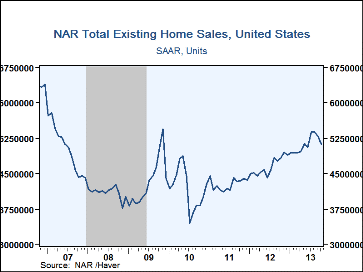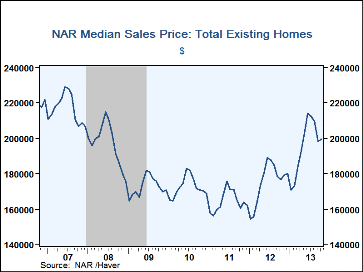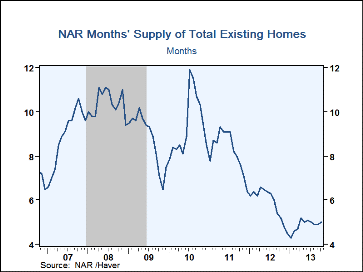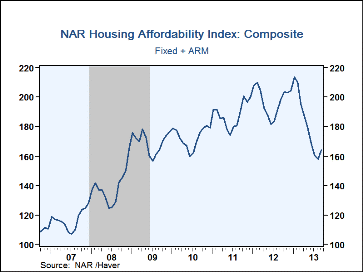 Global| Nov 20 2013
Global| Nov 20 2013U.S. Existing Home Sales Continue To Weaken
by:Tom Moeller
|in:Economy in Brief
Summary
Sales of existing homes declined 3.2% (+6.0% y/y) during October to 5.120 million (AR). The drop followed an unrevised September 1.9% shortfall, according to the National Association of Realtors. Consensus expectations had been for [...]
Sales of existing homes declined 3.2% (+6.0% y/y) during October to 5.120 million (AR). The drop followed an unrevised September 1.9% shortfall, according to the National Association of Realtors. Consensus expectations had been for 5.18 million sales. Sales of existing single-family homes alone fell 4.1% to 4.490 million (+5.2% y/y). These data have a longer history than the total sales series. Sales of condos and co-ops increased 3.3% to 0.630 mil. (12.5% y/y).
The median price of an existing home ticked up 0.5% to $199,500. (+12.8% y/y). The peak was $230,300 in July 2006.
Sales fell across the nation last month. The greatest m/m decline occurred in the West with a 7.1% shortfall (-0.8% y/y). Next was the Northeast which posted a 2.9% sales drop (+11.7% y/y. In the South, sales fell 1.9% m/m (+7.3% y/y) and sales in the Midwest were off 1.6% (+8.0% y/y).
The supply of homes on the market was roughly unchanged at 5.0 months of sales, down from a high of 11.9 months in July of 2010. The actual number of homes on the market increased 0.9% y/y last month. That started to reverse a 21.1% y/y decline during all of last year and a 23.2% drop in 2011.
Reported earlier this month, the September composite index of home price affordability rose 4.0% (-17.2% y/y) as a result of a 3.6% decline (+23.4% y/y) in mortgage payments. The decline was due to a 5.3% fall (+11.0% y/y) in home prices. Average interest rates paid were 4.53%, up from the December low of 3.43%.
The data on existing home sales, prices and affordability can be found in Haver's USECON database. The regional price, affordability and inventory data are available in the REALTOR database. The expectations figure is from the Action Economics survey, reported in the AS1REPNA database.
| Existing Home Sales (SAAR, 000s) | Oct | Sep | Aug | Y/Y % | 2012 | 2011 | 2010 |
|---|---|---|---|---|---|---|---|
| Total | 5,120 | 5,290 | 5,390 | 6.0 | 4,661 | 4,278 | 4,183 |
| Northeast | 670 | 690 | 710 | 11.7 | 596 | 543 | 563 |
| Midwest | 1,220 | 1,240 | 1,320 | 8.0 | 1067 | 918 | 909 |
| South | 2,060 | 2,100 | 2,130 | 7.3 | 1,833 | 1,683 | 1,626 |
| West | 1,170 | 1,260 | 1,230 | -0.8 | 1,165 | 1,133 | 1,084 |
| Single-Family Sales | 4,490 | 4,680 | 4,750 | 5.2 | 4,130 | 3,793 | 3,705 |
| Median Price Total ($, NSA) | 199,500 | 198,500 | 209,700 | 12.8 | 175,442 | 164,542 | 172,442 |
Tom Moeller
AuthorMore in Author Profile »Prior to joining Haver Analytics in 2000, Mr. Moeller worked as the Economist at Chancellor Capital Management from 1985 to 1999. There, he developed comprehensive economic forecasts and interpreted economic data for equity and fixed income portfolio managers. Also at Chancellor, Mr. Moeller worked as an equity analyst and was responsible for researching and rating companies in the economically sensitive automobile and housing industries for investment in Chancellor’s equity portfolio. Prior to joining Chancellor, Mr. Moeller was an Economist at Citibank from 1979 to 1984. He also analyzed pricing behavior in the metals industry for the Council on Wage and Price Stability in Washington, D.C. In 1999, Mr. Moeller received the award for most accurate forecast from the Forecasters' Club of New York. From 1990 to 1992 he was President of the New York Association for Business Economists. Mr. Moeller earned an M.B.A. in Finance from Fordham University, where he graduated in 1987. He holds a Bachelor of Arts in Economics from George Washington University.










